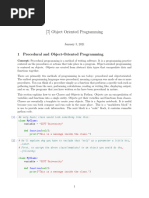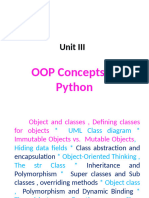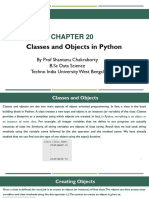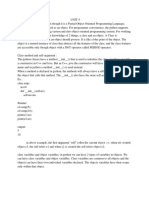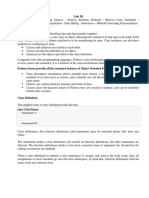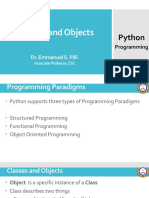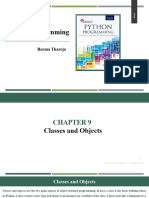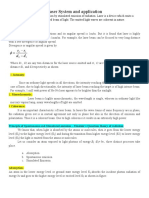Object Oriented Programming Lab 4
Uploaded by
ali ahmedObject Oriented Programming Lab 4
Uploaded by
ali ahmedMarch 27, 2019 Lab 04 – Class Variables and Data Hiding.
Student Name: Roll No: Section:
Lab Series No. 04.
Lab 04 –Class Variables and Data Hiding.
Lab Objectives:
1. Class and Instance Variables
2. Data Hiding
3. Self Parameter
4. Modification to attributes inside the class
1. Class and Instance Variables
In Python, instance variables are variables whose value is assigned inside a constructor or method with
self. Class variables are variables whose value is assigned in class.
Program 1: Write a Python program to create variable inside the class with string value and
accessing it.
Code:
# Python program to show that the variables with a value assigned in
class declaration, are class variables and variables inside methods
and constructors are instance variables.
# Class for Computer Science Student
class CSStudent:
# Class Variable
trade = 'Computer Science Software Engineering'
# The init method or constructor
def init (self, roll):
# Instance Variable
self.roll = roll
# Objects of CSStudent class
Faisal = CSStudent(315)
Farhan = CSStudent(316)
print(Faisal.trade)
print(Faisal.roll)
print(Faisal.trade)
print(Farhan.roll)
Prepared By CS-121 | Object Oriented 1
Programming
March 27, 2019 Lab 04 – Class Variables and Data Hiding.
Student Name: Roll No: Section:
# Class variables can be accessed using class name also
print(CSStudent.trade)
Program 2: Write a Python program to create instance variable inside method and accessing it.
Code:
# Python program to show that the variables with a value assigned in
class declaration, are class variables and variables inside methods
and constructors are instance variables.
# Class for Computer Science Student
class CSStudent:
# Class Variable
trade1 = 'Computer Science'
trade2 = 'Software Engineering'
# The init method or constructor
def init (self, roll):
# Instance Variable
self.roll = roll
# Adds an instance variable
def setAddress(self, address):
self.address = address
# Retrieves instance variable
def getAddress(self):
return self.address
# Objects of CSStudent class
Faisal = CSStudent(315)
Faisal.setAddress("Gulistan e Johar")
print(Faisal.getAddress())
2. Data Hiding
In Python, we use double underscore (Or ) before the attributes name and those attributes will
not be directly visible outside.
Prepared By CS-121 | Object Oriented 2
Programming
March 27, 2019 Lab 04 – Class Variables and Data Hiding.
Student Name: Roll No: Section:
Program 3: Write a Python program which can create a hidden variable inside the class. Then try to
access it.
Code:
class MyClass:
# Hidden member of MyClass
hiddenVariable = 0
# A member method that changes
# hiddenVariable
def add(self, increment):
self. hiddenVariable += increment
print (self. hiddenVariable)
# Executing the Code
myObject = MyClass()
myObject.add(2)
myObject.add(5)
# This line causes error
print (myObject. hiddenVariable)
Program 4: Write a Python program which can create a hidden variable inside the class. Then try to
access it by using tricky method.
Code:
# A Python program to demonstrate that hidden
# members can be accessed outside a class
class MyClass:
# Hidden member of MyClass
hiddenVariable = 10
# Executing code
myObject = MyClass()
print(myObject._MyClass hiddenVariable)
Prepared By CS-121 | Object Oriented 3
Programming
March 27, 2019 Lab 04 – Class Variables and Data Hiding.
Student Name: Roll No: Section:
4. The Self Parameter
The self-parameter is a reference to the current instance of the class, and is used to access
variables that belongs to the class.
It does not have to be named self, you can call it whatever you like, but it has to be the first
parameter of any function in the class:
Program 5: Write a Python program which use other than self keyword for reference .
Code:
class Person:
def init (a, name, age, salary, profession):
a.name = name
a.age = age
a.salary = salary
a.profession = profession
def mydetail(a):
print("Assalam o Alekum, my name is " + a.name +", my age is
:" + str(a.age) +". Now a days earning :"+ str(a.salary) + ", its
really lovely to be a " + a.profession )
person1 = Person("Syed Faisal Ali", 44, 1234567, "Research
Scientist")
person1.mydetail()
Program 6: Write a Python program which can modify the attributes inside the class.
Code:
class Person:
def init (a, name, age, salary, profession):
a.name = name
a.age = age
a.salary = salary
a.profession = profession
def mydetail(a):
print("Assalam o Alekum, my name is " + a.name +", my age is
:" + str(a.age) +". Now a days earning :"+ str(a.salary) + ", its
really lovely to be a " + a.profession )
person1 = Person("Syed Faisal Ali", 42, 1234567, "Research
Scientist")
person1.mydetail()
Prepared By CS-121 | Object Oriented 4
Programming
March 27, 2019 Lab 04 – Class Variables and Data Hiding.
Student Name: Roll No: Section:
print("Need to modify the age and salary inside the class")
person1.age = 44
person1.salary = 7654321
person1.mydetail()
Program 7: Write a Python program which uses the child class to call its own method and then parent
class method.
Code:
class Parent: # define parent class
parentAttr = 100
def init (self):
print ("Calling parent constructor")
def parentMethod(self):
print ('Calling parent method')
def setAttr(self, attr):
Parent.parentAttr = attr
def getAttr(self):
print ("Parent attribute :", Parent.parentAttr)
class Child(Parent): # define child class
def init (self):
print ("Calling child constructor")
def childMethod(self):
print ('Calling child method')
c1 = Child() # instance of child
c1.childMethod() # child calls its method
c1.parentMethod() # calls parent's method
c1.setAttr(200) # again call parent's method
c1.getAttr() # again call parent's method
Prepared By CS-121 | Object Oriented 5
Programming
March 27, 2019 Lab 04 – Class Variables and Data Hiding.
Student Name: Roll No: Section:
Programming Exercise
Task1: Define what you understand by the classes, objects and functionalities for the following
scenarios.
Task 2: Make a class for insurance which can have multiple insurance policies. Design its UML and
Case diagram before coding. Later modify the attributes in child classes.
Task 3: Create a bike class and its components in light with the concept of Object Oriented. Later
create multiple bikes with different attributes based on customer requirements.
Task 7: You are working in Galaxy Computer as Programmer. The main business is selling computer,
laptops its accessories, used computer etc. Details can be find from https://galaxy.pk/. Your task is
to analyze the website, define which classes will be require and create the complete program which
can take user name and its requirements then give the total amount of computer/ laptop or accessories.
Prepared By CS-121 | Object Oriented 6
Programming
You might also like
- Learn As You Play Oboe, Peter Wastall - Cópia PDF100% (4)Learn As You Play Oboe, Peter Wastall - Cópia PDF66 pages
- PP UNIT 4 (Object Oriented Programming)No ratings yetPP UNIT 4 (Object Oriented Programming)67 pages
- Unit - 4 Classes and Object-Oriented ProgrammingNo ratings yetUnit - 4 Classes and Object-Oriented Programming88 pages
- 5.Object Oriented Programming in PythonNo ratings yet5.Object Oriented Programming in Python41 pages
- Unit6_ClassesandObjectspdf__2023_10_17_09_16_10No ratings yetUnit6_ClassesandObjectspdf__2023_10_17_09_16_1031 pages
- Chapter 3 Python Object Oriented ProgrammingNo ratings yetChapter 3 Python Object Oriented Programming80 pages
- Practical9 Python Programming JPZuufeG4QNo ratings yetPractical9 Python Programming JPZuufeG4Q7 pages
- Lecture 9 - Python Classes and InheritanceNo ratings yetLecture 9 - Python Classes and Inheritance32 pages
- Unit V - Object Oriented Programming in PythonNo ratings yetUnit V - Object Oriented Programming in Python50 pages
- Unit V - Object Oriented Programming in PythonNo ratings yetUnit V - Object Oriented Programming in Python55 pages
- IGNOU PGDCA MCS 206 Object Oriented Programming using Java Previous Years solved PapersFrom EverandIGNOU PGDCA MCS 206 Object Oriented Programming using Java Previous Years solved PapersNo ratings yet
- Flares Over-The-Top Beginners Guide To SFXv2.1No ratings yetFlares Over-The-Top Beginners Guide To SFXv2.157 pages
- Detailed Model of A Common Rail InjectorNo ratings yetDetailed Model of A Common Rail Injector12 pages
- Evidence Based Practice in Nursing (EBPN) : IntroduceNo ratings yetEvidence Based Practice in Nursing (EBPN) : Introduce21 pages
- Internal Audit in Focus 2024 1709245839No ratings yetInternal Audit in Focus 2024 170924583911 pages
- Philippine Society of Mechanical Engineers Articles of Incorporation and By-Laws83% (6)Philippine Society of Mechanical Engineers Articles of Incorporation and By-Laws24 pages
- 6 2019 AnalisisKuantitatifHidruquinonpadaProdukKosmetikKrimPemutihyangBeredardiWilayahSurabayaPusatdanSurabayaUtaradenganMetodeSpektrofotometriUV-VisNo ratings yet6 2019 AnalisisKuantitatifHidruquinonpadaProdukKosmetikKrimPemutihyangBeredardiWilayahSurabayaPusatdanSurabayaUtaradenganMetodeSpektrofotometriUV-Vis12 pages
- Surah - Humazah - Dream Tafseer Notes - Nouman Ali Khan100% (4)Surah - Humazah - Dream Tafseer Notes - Nouman Ali Khan20 pages
- Airplane Operational and Functional Test: 1. GeneralNo ratings yetAirplane Operational and Functional Test: 1. General4 pages
- Instant Access to Principles of Microeconomics N. Gregory Mankiw ebook Full ChaptersNo ratings yetInstant Access to Principles of Microeconomics N. Gregory Mankiw ebook Full Chapters54 pages
- Subcostal TAPSE - A Retrospective Analysis of A Novel Right Ventricle Function Assessment Method From The Subcostal Position in Patients With SepsisNo ratings yetSubcostal TAPSE - A Retrospective Analysis of A Novel Right Ventricle Function Assessment Method From The Subcostal Position in Patients With Sepsis8 pages
- Linux in Action David Clinton pdf download100% (1)Linux in Action David Clinton pdf download34 pages
- Laser System and Application: DirectionalityNo ratings yetLaser System and Application: Directionality19 pages





